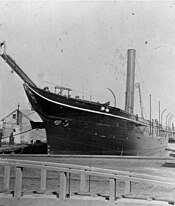
USS Thresher (SSN-593) was the lead boat of her class of nuclear-powered attack submarines in the United States Navy. She was the U.S. Navy's second submarine to be named after the thresher shark.

USS Kearsarge, a Mohican-class sloop-of-war, is best known for her defeat of the Confederate commerce raider CSS Alabama off Cherbourg, France during the American Civil War. Kearsarge was the only ship of the United States Navy named for Mount Kearsarge in New Hampshire. Subsequent ships were later named Kearsarge in honor of the ship.

The second USS California (ACR-6), also referred to as "Armored Cruiser No. 6", and later renamed San Diego, was a United States Navy Pennsylvania-class armored cruiser.
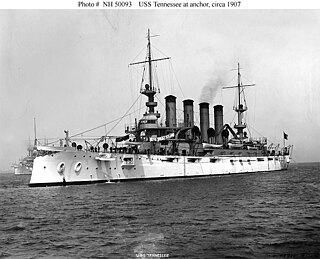
The second USS Tennessee (ACR-10), also referred to as "Armored Cruiser No. 10", and later renamed Memphis, was a United States Navy armored cruiser, the lead ship of her class.
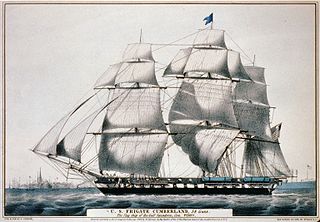
The first USS Cumberland was a 50-gun sailing frigate of the United States Navy. She was the first ship sunk by the ironclad CSS Virginia.

USS Perch (SS-176) - a Porpoise-class submarine, was the first ship of the United States Navy to be named for the perch.

The second USS Alliance was a screw gunboat that was in service from 1877–1911 with the United States Navy.

USS Higbee (DD/DDR-806) was a Gearing-class destroyer in the United States Navy during World War II. She was the first U.S. warship named for a female member of the U.S. Navy, being named for Chief Nurse Lenah S. Higbee (1874–1941), a pioneering Navy nurse who served as Superintendent of the U.S. Navy Nurse Corps during World War I.

USS Monongahela (1862) was a barkentine–rigged screw sloop-of-war that served in the Union Navy during the American Civil War. Her task was to participate in the Union blockade of the Confederate States of America. Post-war, she continued serving her country in various roles, such as that of a storeship and schoolship.

The first USS Trenton was a wooden-hulled screw steamer, classified as a screw frigate, in the United States Navy. She was named for Trenton, New Jersey.

The first USS Shark was a schooner in the United States Navy. Built in the Washington Navy Yard to the designs of Henry Steers, Shark was launched on 17 May 1821. On 11 May 1821, Matthew C. Perry was ordered to take command of Shark, and the ship was ready to receive her crew on 2 June 1821.
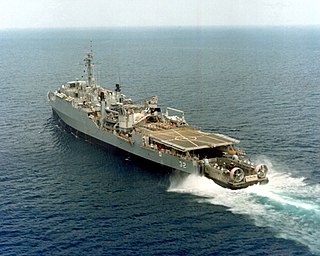
USS Spiegel Grove (LSD-32) was a Thomaston-class dock landing ship of the United States Navy. She was named for Spiegel Grove, the home and estate in Fremont, Ohio of Rutherford B. Hayes, the 19th President of the United States.

USS Strong (DD-467), was a Fletcher-class destroyer and the first ship of the United States Navy to be named after Rear Admiral James H. Strong (1814–1882), who rammed the Confederate ironclad CSS Tennessee during the Battle of Mobile Bay, receiving a commendation and promotion to captain.
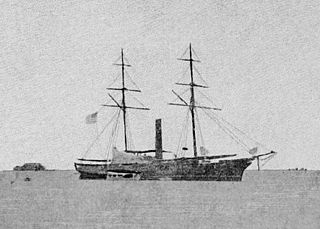
The first USS Saginaw was a sidewheel sloop-of-war in the United States Navy during the American Civil War. The ship was in operation throughout the 1860s, but in 1870 wrecked on what is now known as Kure Atoll, a Pacific island. The event produced several books and one of the surviving boats from the ship is in a museum.

USS Albany, the first United States Navy ship of that name, was built in the 1840s for the US Navy. The ship was among the last of the wooden sloops powered by sail and saw extensive service in the Mexican War. Before and after her combat service, Albany conducted surveillance and observation missions throughout the Caribbean. In September 1854, during a journey along the coast of Venezuela, Albany was lost with all hands on 28 or 29 September 1854. Included among the 250 men lost were several sons and grandsons of politically prominent men.

USS Castine (PG-6) was a gunboat of the United States Navy in commission from 1894 to 1901, from 1903 to 1905, and from 1908 to 1919. The first U.S. Navy ship named for Castine, Maine, she saw service during the Spanish–American War, the Philippine–American War, and World War I.
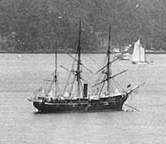
As part of the Secretary of the Navy George M. Robeson's plans to overhaul and modernize ships of the Navy, the first USS Swatara was taken to the New York Navy Yard in 1872, ostensibly for "repairs". In fact, the "repairs" constituted construction of a new ship, for Swatara was given a new hull and unused machinery which had been in storage since 1865. Embodying only certain fittings and equipment from the first ship, the second Swatara was launched on 17 September 1873 at the New York Navy Yard and commissioned on 11 May 1874, Capt. Ralph Chandler in command.

SS Friedrich der Grosse was a Norddeutscher Lloyd liner built in 1896 which sailed Atlantic routes from Germany and sometimes Italy to the United States and on the post run to Australia. At the outset of World War I the ship was interned by the U.S. and, when that country entered the conflict in 1917, was seized and converted to a troop transport, becoming USS Huron (ID-1408).
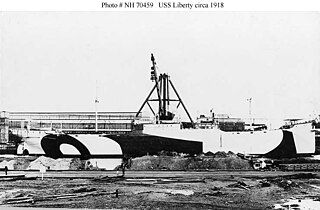
USAT Liberty was a United States Army cargo ship torpedoed by Japanese submarine I-166 in January 1942 and beached on the island of Bali, Indonesia. She had been built as a Design 1037 ship for the United States Shipping Board in World War I and had served in the United States Navy in that war as animal transport USS Liberty (ID-3461). She was also notable as the first ship constructed at Federal Shipbuilding, Kearny, New Jersey. In 1963 a volcanic eruption moved the ship off the beach, and Liberty's wreck is now a popular dive site.
Antonio Williams (1825–1908) was a seaman first class serving in the United States Navy who received the Medal of Honor for bravery.
